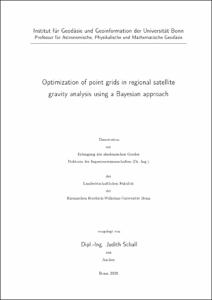Schall, Judith: Optimization of point grids in regional satellite gravity analysis using a Bayesian approach. - Bonn, 2020. - Dissertation, Rheinische Friedrich-Wilhelms-Universität Bonn.
Online-Ausgabe in bonndoc: https://nbn-resolving.org/urn:nbn:de:hbz:5-58149
Online-Ausgabe in bonndoc: https://nbn-resolving.org/urn:nbn:de:hbz:5-58149
@phdthesis{handle:20.500.11811/8182,
urn: https://nbn-resolving.org/urn:nbn:de:hbz:5-58149,
author = {{Judith Schall}},
title = {Optimization of point grids in regional satellite gravity analysis using a Bayesian approach},
school = {Rheinische Friedrich-Wilhelms-Universität Bonn},
year = 2020,
month = mar,
note = {The subject of this thesis is the global and regional gravity field determination from GOCE data using the short arc approach. The focus is on the extension of the regional method regarding an adaption of the model resolution to the data by estimating an optimal nodal point configuration for the arrangement of the radial basis functions. Estimating the positions of the basis functions is a nonlinear problem, which is not easy to solve with the means of classical adjustment theory. This is especially true if the number of basis functions is to be determined from the data as well. It is for this reason that the point grid has been fixed so far, and only the linear problem, that is the determination of the scaling coefficients for a given point grid, has been solved. Here, the problem is formulated within the framework of Bayesian statistics by specifying a joint posterior density for the number of the basis functions and the rest of the parameters. For the practical solution, the reversible jump Markov chain Monte Carlo sampling algorithm is employed, which allows simulating this kind of variable dimension problem. Key points in the implementation of the approach are the marginalization of the scaling coefficients from the target density, which enables me to limit the chain to the sampling of the point grid, and the use of a proposal distribution derived from a gravity field model. The final gravity field solution is taken to be the average of the generated gravity field solutions and thus takes into account the uncertainty about the choice of the model. The method is applied to real GOCE data and compared with the global spherical harmonic model ITG-Goce02 and a regional solution that makes use of a regular distribution of basis functions. Being a part of this work, the comparison models are based on the same processing strategy. It turns out that the optimization of the point grid enormously reduces the required number of basis functions, and that the distribution of the grid points becomes adapted to the structures of the gravity field signal. The solution becomes more stable and better reflects the characteristics of the signal. This entails an improvement of up to 13% over the mentioned comparison models.},
url = {https://hdl.handle.net/20.500.11811/8182}
}
urn: https://nbn-resolving.org/urn:nbn:de:hbz:5-58149,
author = {{Judith Schall}},
title = {Optimization of point grids in regional satellite gravity analysis using a Bayesian approach},
school = {Rheinische Friedrich-Wilhelms-Universität Bonn},
year = 2020,
month = mar,
note = {The subject of this thesis is the global and regional gravity field determination from GOCE data using the short arc approach. The focus is on the extension of the regional method regarding an adaption of the model resolution to the data by estimating an optimal nodal point configuration for the arrangement of the radial basis functions. Estimating the positions of the basis functions is a nonlinear problem, which is not easy to solve with the means of classical adjustment theory. This is especially true if the number of basis functions is to be determined from the data as well. It is for this reason that the point grid has been fixed so far, and only the linear problem, that is the determination of the scaling coefficients for a given point grid, has been solved. Here, the problem is formulated within the framework of Bayesian statistics by specifying a joint posterior density for the number of the basis functions and the rest of the parameters. For the practical solution, the reversible jump Markov chain Monte Carlo sampling algorithm is employed, which allows simulating this kind of variable dimension problem. Key points in the implementation of the approach are the marginalization of the scaling coefficients from the target density, which enables me to limit the chain to the sampling of the point grid, and the use of a proposal distribution derived from a gravity field model. The final gravity field solution is taken to be the average of the generated gravity field solutions and thus takes into account the uncertainty about the choice of the model. The method is applied to real GOCE data and compared with the global spherical harmonic model ITG-Goce02 and a regional solution that makes use of a regular distribution of basis functions. Being a part of this work, the comparison models are based on the same processing strategy. It turns out that the optimization of the point grid enormously reduces the required number of basis functions, and that the distribution of the grid points becomes adapted to the structures of the gravity field signal. The solution becomes more stable and better reflects the characteristics of the signal. This entails an improvement of up to 13% over the mentioned comparison models.},
url = {https://hdl.handle.net/20.500.11811/8182}
}






